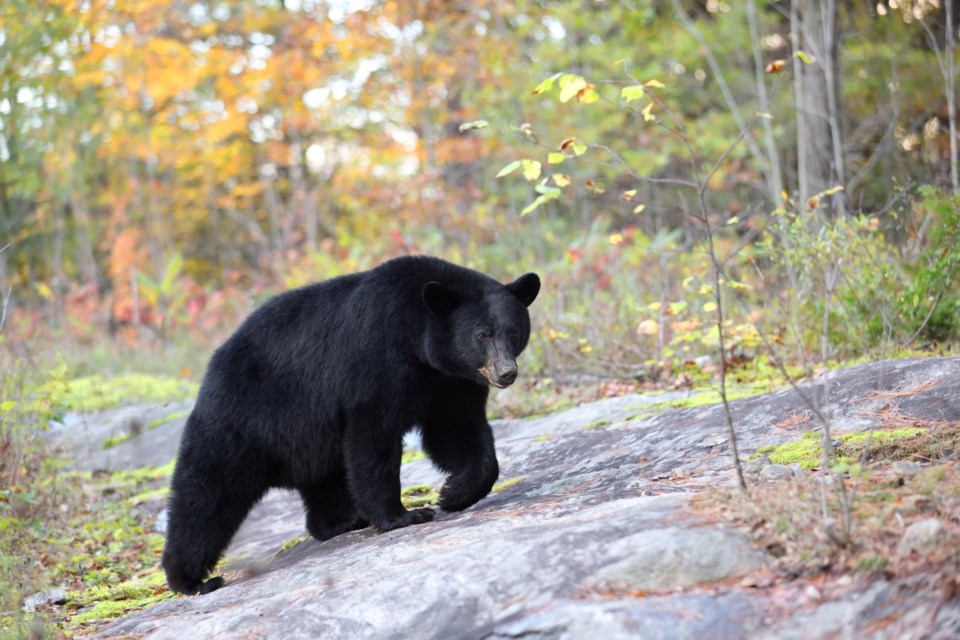Temperatures might have finally dropped, but Whistler’s black bears aren’t settled in their dens for the winter just yet.
October got off to a particularly hectic start for local conservation officers, beginning with complaints about a bear breaking into “several” homes in the Nordic area and accessing meals from freezers and fridges, said Tim Schumacher with the B.C. Conservation Officer Service (COS).
Ultimately, those incidents earned the bear a death sentence. “It was seeking food inside of homes, and damaging homes and forcing entry to get that food, so unfortunately that bear had to be destroyed,” Schumacher said.
Conservation officers trapped and killed the animal on Oct. 6. It marked the fourth black bear lost to conflict within Whistler’s municipal boundaries this year.
The same day, a sow and two cubs similarly found their way into a Whistler home, causing damage to the property and retrieving food from the kitchen. Conservation officers were alerted to the incident after it was reported to 911.
Though it typically only takes a bear entering one home on one occasion for conservation officers to deem that animal a public safety risk, “In this instance, she was tagged and released,” Schumacher said. “She was basically given a second chance.”
Cubs add a layer of complexity to human-wildlife conflict—and to conservation officers’ response. Essentially, if the sow was killed, “you’d be orphaning those two cubs and they would have to go to a care facility,” Schumacher explained. “Nature can always do better than what we can as far as [a] mom teaching her cubs how to find food and how to go about their life processes.”
Finally, conservation officers rounded out their Oct. 6 shift—“a very long, busy day,” as Schumacher recalled—by trapping and relocating a third black bear that had been frequenting Whistler Village, an area the Sea to Sky’s COS team considers “a no-go bear zone.”
The bear was one of at least three that had been regularly observed in Whistler Village throughout the summer, said Schumacher. “Given the amount of people that are frequenting the village on a regular basis, we consider it a confined area and we move bears out of that area either through hazing—basically scaring them away using different tactics and tools that we have—or by relocation,” he explained.
Relocation entails moving the animal a short distance away, usually no further than about 10 kilometres, Schumacher said. “We’re just trying to get them out of the wrong place at the wrong time—we don’t want to take the bear out of its … home range,” he explained. “Through consultation with our biologist, keeping bears within their home range is the most humane thing to do.”
Even after temperatures fell to more seasonal norms late last week, black bears remain active throughout the resort, Schumacher said. Conservation officers were still working to deter bears from the village and the nearby Glacier Reach complex as recently as Monday, Oct. 24.
Whistler locals and visitors are reminded to properly manage attractants—for example, storing garbage out of reach, keeping barbecues and grease traps clean and managing mountain ash trees near residential properties—in addition to keeping home and vehicle windows closed, doors locked, and most importantly, ensuring all food waste is properly discarded in the village’s bear-safe waste bins, even amid the cooler weather.
“If [bins] are left ajar throughout the day … or if it’s overflowing, then a bear will end up getting a food reward, and that keeps them coming back into these confined areas,” said Schumacher, adding that the animals are particularly “persistent because it’s a higher-calorie meal that they can get, especially at this time of year when they’re going into hyperphagia.”
According to the Get Bear Smart Society, hyperphagia is the period before hibernation where bears’ appetites grow, “driven by a biological need to fatten up” before they head into their dens. That, in turn, results in increased feeding activity—upwards of 20 hours a day—with some bears “going to some pretty extreme measures” to earn their pre-winter calories.
Sightings of bears near properties can be reported to the COS at 1-877-952-7277—that allows the COS to respond with non-lethal hazing in an effort to deter the animals from the area before their behaviour escalates—while unsecured animal attractants should be reported to Whistler’s Bylaw Services at 604-935-8280 or bylawservices@whistler.ca.
“If there’s no food source for the bear, then the bear’s either going to pass through or not be there in the first place,” said Schumacher. Securing attractants is “the best way we can manage bears within our community to keep them and people safe,” he added




